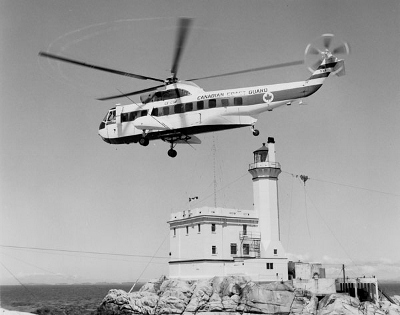Triple Islands Lighthouse
Heritage Lighthouse
Skeena-Queen Charlotte A, British Columbia

Historic photograph
© Library and Archives Canada, Department of Transport | Bibliothèque et Archives Canada, Ministère des Transports, e008128980
Address :
Triple Islands, Skeena-Queen Charlotte A, British Columbia
Recognition Statute:
Heritage Lighthouse Protection Act (S.C. 2008, c 16)
Designation Date:
2015-02-12
Dates:
-
1920 to 1920
(Construction)
-
1913 to 1913
(Established)
Event, Person, Organization:
-
Colonel William P. Anderson
(Architect)
Description of Historic Place
The Triple Islands Lighthouse is an octagonal, reinforced concrete tower measuring 23 metres (76 feet) high. It is attached to the corner of a square, three-storey, reinforced concrete structure that serves as the keepers’ dwelling and equipment building. The lighthouse is located on the northwesterly rock of a group of three islets known as the Triple Islands at the western entrance of Brown Passage. It was built in 1920 to guide marine traffic traveling from the Inside Passage to Alaska, as well as for deep-sea ships navigating to and from Prince Rupert. There is one related building on the site that contributes to the heritage character of the lighthouse: (1) the 1920 storage shed.
Heritage Value
The Triple Islands Lighthouse is a heritage lighthouse because of its historical, architectural, and community values.
Historical values
The Triple Islands Lighthouse is an excellent example of improvement of the system of aids to navigation along British Columbia’s coast. The construction of the lighthouse was a unique challenge due to the treacherous conditions on the exposed rock, leading to thousands of dollars worth of material being lost. The construction is recognized nationally as one of the most hazardous construction projects in Canadian maritime history, which led to its designation as a National Historic Site. The lighthouse is also associated with the shipwreck history of British Columbia’s west coast, including the wreck of the SS Prince Albert.
Triple Islands Lighthouse is an excellent example of the socio-economic development of the region. With the aspiration of Prince Rupert to become a gateway to Asia, the lighthouse aided the town in becoming a major international port. The maritime community of fishing vessels, commercial transport vessels, tourist cruise ships, and pleasure craft all rely on the lighthouse for safe travel through the hazardous Brown Passage and Hecate Strait.
Architectural values
The Triple Islands Lighthouse is an excellent example of an octagonal, reinforced concrete lighthouse. The lighthouse is a simplified, well-scaled, classical design that features more elaborate details than previous concrete towers. Because it was designed and built to conform to its specific site, there is no lighthouse in Canada that compares directly with the design at Triple Islands. It is a unique, high-integrity site consisting of classical features and proportions.
The Triple Islands Lighthouse is an excellent engineering triumph in Canadian lighthouse design. Anchored securely to the rock beneath it, the Triple Islands Lighthouse is an amazing technological accomplishment that has withstood severe climatic conditions, high winds and massive tidal waves.
Community values
The Triple Islands Lighthouse establishes the maritime character of the area. The natural environment engulfing the Triple Islands Lighthouse is a notable feature of its setting and represents a significant aspect of its maritime history. The lighthouse evokes the popular image of a sturdy fortress standing strong in the face of fearsome storms.
The Triple Islands Lighthouse is a symbol of the Prince Rupert and Haida Gwaii maritime communities. It is highly valued and appreciated by these communities and the larger coastal community. Known locally as “The Rock” or “Little Alcatraz,” the Triple Islands Lighthouse is a familiar landmark for captains, crew, and passengers on both ships and aircraft.
Related buildings
One related building, as listed in section 1, contributes to the heritage character of the lighthouse.
Character-Defining Elements
The following character-defining elements of the Triple Islands Lighthouse should be respected:
— its location on a rugged, rocky location at the western entrance of Brown Passage;
— its intact, as-built structural form, height, profile, and balanced proportions;
— its attached three-storey structure that serves as the keepers’ dwelling and equipment building;
— its square base and its octagonal tower of reinforced-concrete;
— its twelve-sided iron lantern;
— its concrete gallery with a circular metal railing surrounding the lantern;
— its decorative brackets at the roof cornice supporting the lantern’s platform;
— the interior hardwood column and stairs;
— its painted shingles cladding the tower;
— its flared lantern platform;
— the placement of its doors and windows;
— its traditional red and white exterior colour scheme consisting of a white tower and keeper’s dwelling, and red for the lantern, its roof, and the gallery railing, and,
— its visual prominence in relation to the water and landscape.
The following character-defining elements of the related building should be respected:
— its built form and proportions
— its traditional colour scheme consisting of white for the walls and red for the trim and roof; and,
— its contextual relationship to the lighthouse within a lightstation setting.